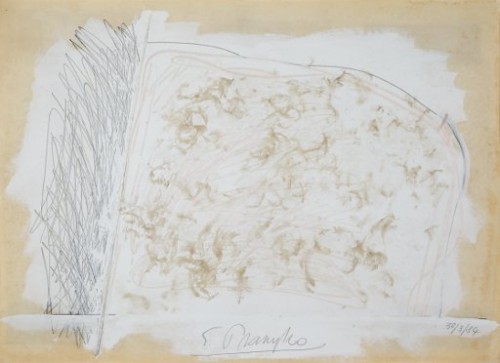Dibujos abstractos
PRANYKO, Stipo
2012
Técnica: Mixta sobre papel
Medidas:
Número de registro: TEA2013-048
Donación del artista Colección TEA Tenerife Espacio de las Artes Cabildo Insular de Tenerife
VIVIR LA VIDA /LIVING A LIFE
“Lo que interesa de Stipo Pranyko es una actitud vital: su búsqueda de unas medidas adecuadas. Esto constituye el centro de su obra. Es una búsqueda que se articula en múltiples niveles, acentuando, como si dijéramos, toda una gama de insistencias: la necesidad de que la presencia no sea obstrusiva; la importancia ética de hacer arte con lo que esté más a mano; la unión del vacío, la sencillez y la luz, que simbolizan tanto un valor trascendental como vital; la falta de apego a las cosas materiales. Se queda deliberadamente fuera, se toma el trabajo de ir contra la moda. Es un perdedor por voluntad propia si lo que está en juego es el éxito mundano”.
“What is at skate with Stipo Pranyko is an attitude towards living: the search for adequate measures. This is what lies at the heart of this work. It is a search that articulates itself at numerous levels, stressing, as it were, a whole range of insistences: the need for unobtrusive presence; the ethical emphasis on making art with whatever is at hand; the espousal of emptiness, simplicity, and light as symbolising both vital and transcendental value; the non-attachment to material things. It amounts to an existential elaboration of a system of beliefs. He is deliberately, indeed painstakingly, an unfashionable outsider, a willing looser if the stakes are those of the search for mundane success”.
[Kevin Power, “Stipo Pranyko: Vivir la vida”, en Stipo Pranyko. Retrospectiva. Fundación César Manrique, 1999].
La fascinación de la simplicidad
“Los papeles y los lienzos casi siempre son blancos, como el resto de los materiales y de los objetos hallados integrados. Esto confiere a las obras un aura de pureza y de calma. Aunque son abstractos, sin elementos figurativos, cuentan historias. Tienen sus raíces en la niñez y en las experiencias posteriores de la vida del artista, se conectan con personas, lugares y sentimientos. Por ejemplo, Gran arrozal recuerda al campo de arroz Italia, donde Stipo Pranyko vivió durante mucho tiempo. La tienda abandonada hace alusión a la tiendecilla de su padre, Cuadro con barra al funambulista del circo. La maleta de Pavel Chapalec es un homenaje al representante comercial que dos veces al año era invitado a comer por su padre y llevaba consigo una maleta llena de muestras. Cuadro con cuchara habla de la pobreza de los padres (se casaron en 1918) que después de que hubiese sonado la sirena de la fábrica, se tumbaban en la hierba: solo poseían una cuchara, por lo que se turnaban para comer de la olla con dos asas. La cuchara del cuadro la encontró Stipo Pranyko en El Golfo. Con el título Hambar pasa de su antigua a su nueva patria: Hambar, el granero, es una palabra de origen árabe y también una palabra bosnia”.
“The paper and canvases are largely white, as are the other materials and the incorporated artefacts, giving the works an aura of purity and calm. Although the works are not representational and do not include figurative elements, they tell stories. They are rooted in the childhood and later life experiences of the artists and establish ties with people, places and feelings. Gran arrozal conjures up the paddy field in Italy, where Stipo Pranyko lived for many years. La tienda abandonada (the abandoned shop) alludes to his father’s curiosity shop, while Cuadro con barra (picture with pole) is a nod to tightrope dancers in the circus. La maleta de Pavel Chapalec (the suitcase of Pavel Chapalec) is a homage to the sales representative who was invited to dinner at his father’s house twice a year and who carried samples of goods with him his suitcase. Cuadro con cuchara (picture with spoon) portrays the poverty of his parents, married in 1918, who, on hearing the home-time siren of the factory, lay down in a meadow and took it in turns to eat from the two-handled pot with the only spoon they possessed. Pranyko found the spoon which is in the picture in the village of El Golfo. The work entitled Hambar builds a bridge between his old and his new home: Hambar, a granary, being both a Spanish term of Arabic origin and a Bosnian word”.
[Petra Giloy-Hirtz, “Stipo Pranyko. La fascinación de la simplicidad” en Stipo Pranyko. La fascinación de la simplicidad, Centro de Arte Convento Santo Domingo, 2011].
